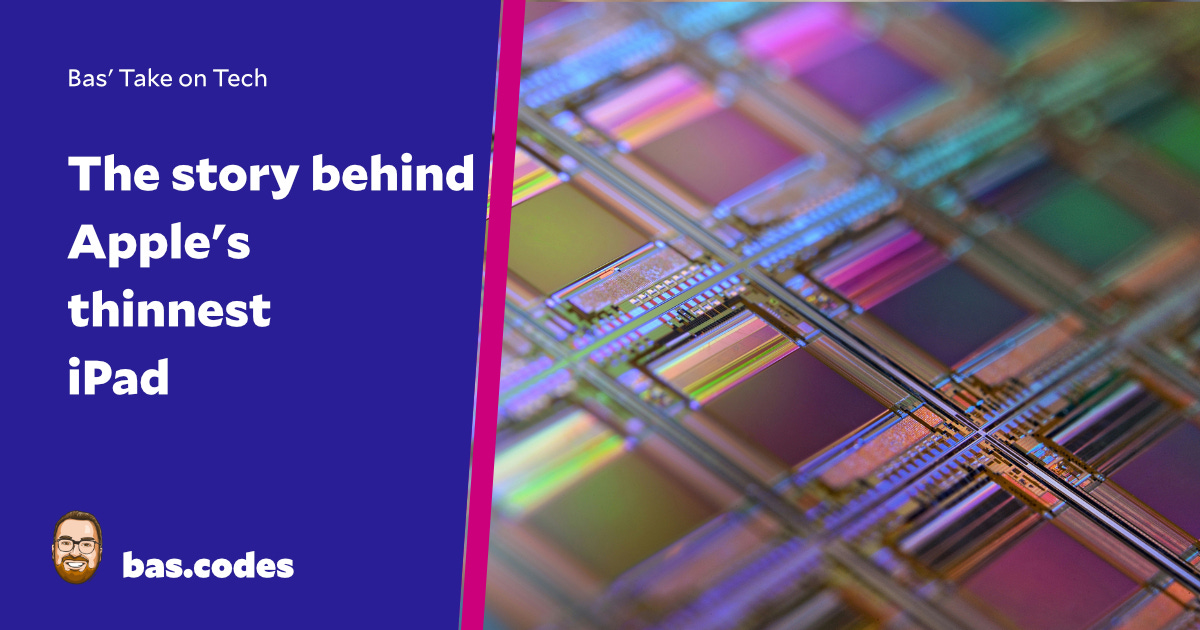Bas' Take on Tech: The story behind Apple's thinnest iPad
Hi there,
thanks for reading my tech newsletter about the recent buzz in tech.
Have a great week ahead!
📱 Apple Introduces the M4
At the last Apple Event, the company introduced a new iPad. Why is that relevant news?
The accompanying commercial did not have a single living being involved, yet Apple had to apologize for hurting feelings. Are we really that sensitive?
For the first time, Apple’s ARM chip was introduced in an iPad, not in a Mac first
The iPad being the thinnest Apple device of all time now, brings some Jony Ive vibes back
Ok, all of that is gossip. But there is another story behind the M4.
Let’s start with Apple’s reasoning behind “Apple Silicon”. When you think of CPUs, you might think of gaming computers, laptops, and servers. In those markets combined, Apple is a small player with approx. 10% market share in the desktop market (and arguably 0% in the server market). However, nowadays smartphones and tablets outperform entry-level desktop hardware and are shipped in two orders of magnitude.
Flashback to the 90s: The rise of the home computer. After the success of the 286, 386, and 486, Intel’s “Pentium” processor became the best-selling CPU of that time, and it was timed very well: In essence, it marked the era of the personal computer. At that time, CPU companies had to produce their own chips. There was no TSMC in Taiwan. And speaking of manufacturing capabilities, Intel had a lot of it, giving them a competitive advantage in terms of unit costs. The x86 CPU (the “Pentium” being the 586) is a “complex instruction set computer” (CISC) and could be produced by Intel’s blue men at low unit costs. The Intel CPU competed with “Reduced Instruction Set Computers” (RISC), which were simpler to design and easier to produce. The only problem: The manufacturers like Sun Microsystems, Silicon Graphics, HP, IBM, (and Apple) and others didn’t have the production capabilities and aimed for a market of high-end workstations. As a result, they needed fewer chips and ended up with higher unit costs despite the simpler architecture.
Back to today: The market has completely flipped. As mentioned in the introduction, small computers, like smartphones, tablets, bike computers, toasters and fridges account for many, many more units than traditional workstations, laptops, or servers. That’s why RISC processors won the second half of the architecture wars. That’s also why Apple is making their own CPUs: In 2020, Intel and AMD combined sold approximately 275 million x86 CPUs – while Apple sold 285 million devices (Macs, iPads, and iPhones) – each with their own chip.
In the RISC market, there exist arguably two competing designs: ARM and RISC-V. Apple’s Silicon chips are based on the ARM architecture which is licenced by ARM Holdings plc (which now belongs to Nvidia whose GPUs are RISC processors basically).
The success of the CPU manufacturer Apple, Inc (skilfully disguised as a lifestyle tech gadget company) brought the competition onto the scene: Microsoft (which tries to make Windows work on ARM) and Qualcomm (another ARM licensee) showed benchmarks for the freshly released Snapdragon X that beat Apple’s M3. Maybe that’s the reason why Apple released the M4 in a hurry for the iPad before releasing the new Macs.
But what about the RISC-V chips? In contrast to ARM’s RISC designs, the RISC-V design is essentially open source and overseen by the non-profit RISC-V foundation. However, its design is far less performant and energy efficient. It could play a huge geopolitical role, though. Trade and patent wars with China and sanctions imposed on Russia could lead to greater pressure to innovate on that platform. China already has huge manufacturing capabilities – not as sophisticated as Taiwan, but they will likely catch up. If they do, that could disrupt the whole chip market with all implications. US lawmakers already investigated how to potentially restrict China’s use of the open platform.
On a side note, it’s interesting to see that the perceived shift in buzz from Crypto to AI has also a technological foundation in the sense that both depend on RISC chips, with Nvidia profiting on both use cases. Well done, Nvidia.
📰 More headlines
Google built some of the first social apps for Android, including Twitter and others
Google Cloud accidentally deletes UniSuper’s online account due to ‘unprecedented misconfiguration’
Exploring Hacker News by mapping and analyzing 40 million posts and comments for fun
Amazon S3 will no longer charge for several HTTP error codes
🚀 What else?
I have changed this newsletter from “occasional” to at least once every two weeks. The new format not only contains curated news and insights from the tech world but also sets the stage for fellow developers.
I will ask people about their journeys in the tech world and also in life. I’m pretty sure there is much to learn from listening to other people’s experiences, and I am excited to share that with you!
Of course, I need your help with this.
Please tell me if you want to share your story with my 600+ readers!
What is something you learned?
What are some books that recently influenced you?
What do you want to share with others about your life, your productivity, your career, and your health?
Reach out to me on this form.
Let me know how I can make the newsletter better.
I set up a short feedback form here.
It would mean the world to me if you spent a minute or two filling it out!
Best,




